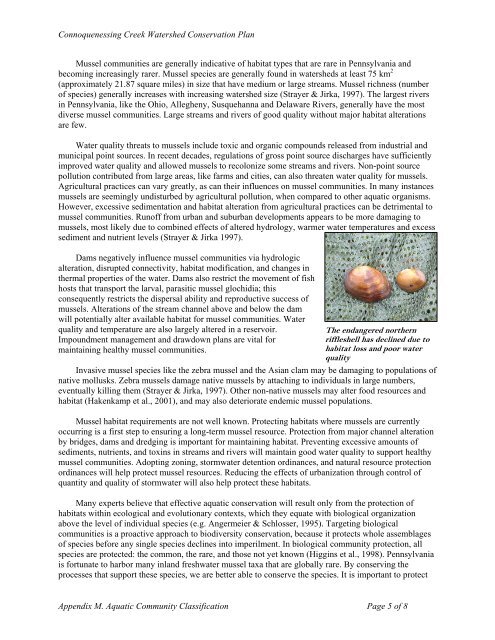Connoquenessing Creek Watershed Conservation Plan - Western ...
Connoquenessing Creek Watershed Conservation Plan - Western ...
Connoquenessing Creek Watershed Conservation Plan - Western ...
- No tags were found...
Create successful ePaper yourself
Turn your PDF publications into a flip-book with our unique Google optimized e-Paper software.
<strong>Connoquenessing</strong> <strong>Creek</strong> <strong>Watershed</strong> <strong>Conservation</strong> <strong>Plan</strong>Mussel communities are generally indicative of habitat types that are rare in Pennsylvania andbecoming increasingly rarer. Mussel species are generally found in watersheds at least 75 km 2(approximately 21.87 square miles) in size that have medium or large streams. Mussel richness (numberof species) generally increases with increasing watershed size (Strayer & Jirka, 1997). The largest riversin Pennsylvania, like the Ohio, Allegheny, Susquehanna and Delaware Rivers, generally have the mostdiverse mussel communities. Large streams and rivers of good quality without major habitat alterationsare few.Water quality threats to mussels include toxic and organic compounds released from industrial andmunicipal point sources. In recent decades, regulations of gross point source discharges have sufficientlyimproved water quality and allowed mussels to recolonize some streams and rivers. Non-point sourcepollution contributed from large areas, like farms and cities, can also threaten water quality for mussels.Agricultural practices can vary greatly, as can their influences on mussel communities. In many instancesmussels are seemingly undisturbed by agricultural pollution, when compared to other aquatic organisms.However, excessive sedimentation and habitat alteration from agricultural practices can be detrimental tomussel communities. Runoff from urban and suburban developments appears to be more damaging tomussels, most likely due to combined effects of altered hydrology, warmer water temperatures and excesssediment and nutrient levels (Strayer & Jirka 1997).Dams negatively influence mussel communities via hydrologicalteration, disrupted connectivity, habitat modification, and changes inthermal properties of the water. Dams also restrict the movement of fishhosts that transport the larval, parasitic mussel glochidia; thisconsequently restricts the dispersal ability and reproductive success ofmussels. Alterations of the stream channel above and below the damwill potentially alter available habitat for mussel communities. Waterquality and temperature are also largely altered in a reservoir.Impoundment management and drawdown plans are vital formaintaining healthy mussel communities.The endangered northernriffleshell has declined due tohabitat loss and poor waterqualityInvasive mussel species like the zebra mussel and the Asian clam may be damaging to populations ofnative mollusks. Zebra mussels damage native mussels by attaching to individuals in large numbers,eventually killing them (Strayer & Jirka, 1997). Other non-native mussels may alter food resources andhabitat (Hakenkamp et al., 2001), and may also deteriorate endemic mussel populations.Mussel habitat requirements are not well known. Protecting habitats where mussels are currentlyoccurring is a first step to ensuring a long-term mussel resource. Protection from major channel alterationby bridges, dams and dredging is important for maintaining habitat. Preventing excessive amounts ofsediments, nutrients, and toxins in streams and rivers will maintain good water quality to support healthymussel communities. Adopting zoning, stormwater detention ordinances, and natural resource protectionordinances will help protect mussel resources. Reducing the effects of urbanization through control ofquantity and quality of stormwater will also help protect these habitats.Many experts believe that effective aquatic conservation will result only from the protection ofhabitats within ecological and evolutionary contexts, which they equate with biological organizationabove the level of individual species (e.g. Angermeier & Schlosser, 1995). Targeting biologicalcommunities is a proactive approach to biodiversity conservation, because it protects whole assemblagesof species before any single species declines into imperilment. In biological community protection, allspecies are protected: the common, the rare, and those not yet known (Higgins et al., 1998). Pennsylvaniais fortunate to harbor many inland freshwater mussel taxa that are globally rare. By conserving theprocesses that support these species, we are better able to conserve the species. It is important to protectAppendix M. Aquatic Community Classification Page 5 of 8














